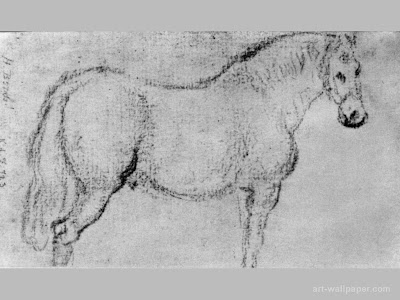Pieter Bruegel Biography
Wednesday, September 8, 2010
Name: Pieter Bruegel (The Elder)
Born: Breda (?), Netherlands
c.1525-30
Died: Brussels, Flanders (modern Belgium)
September 1569
Although Bruegel was famous in his own lifetime, the archaic appearance of much of his imagery and his disinclination to adopt the idealized style of portraiture developed by the Italian Renaissance artists had, at least in sophisticated circles, an adverse effect on his reputation both during his lifetime and after his death. Since his works did not conform to the aesthetic theories of the time, the early art historians were inclined to disregard him and indeed there appears to have been little serious academic study of his work until the 20th century. Furthermore there are no extant records of his thoughts on art and no letters by his hand survive. The result is therefore an absence of significant detail concerning much of his life.
The date and place of his birth are still not certain, although between 1525 and 1530 somewhere near Breda in the Netherlands is considered most likely. Until 1559 he spelt his name 'Brueghel', then changing to 'Bruegel'. The reason for this is unknown. According to the painter-historian Carel van Mander who included a life of the artist in his Schilderboek of 1604, and who is the chief source of our knowledge about his life, the young Bruegel was apprenticed to Pieter Coeck van Aelst, a successful artist in the Italian style who maintained studios in Antwerp and Brussels, where he died in 1550. He will doubtless have known his master's series of woodcuts depicting Turkish life and manners, based on drawings made in 1533. Although appearing strange to the modern viewer, they might well have influenced an impressionable young man with their rich embellishment of exotic facts - the familiarization of the strange and bizarre through the addition of circumstantial detail.
In 1551 Bruegel had completed his training and became a Master of the Painters' Guild of Antwerp. For the greater part of the following three years, however, he appears to have travelled abroad. In 1552 he was in the south of Italy, visiting Reggio, Messina, Palermo and Naples. In 1553 he was in Rome where he met the well-known painter and miniaturist of the day, Giulio Clovio (later a friend of El Greco), who acquired a number of his works (now lost), including a small-scale picture of the Tower of Babel (BRP004), painted on ivory, and a View of Lyons painted in watercolours on Linen. He also painted a picture in collaboration with Clovio. It is possible that he was taught the watercolour technique by Pieter Coeck van Aelst's wife, Mayken, who specialised in this medium. During this journey he also made an extensive series of drawings of the Alps, indicating that he already had an interest in landscape.
On his return to Flanders, Bruegel began working for the Antwerp engraver and print-seller, Hieronymus Cock, and his Alpine drawings formed the basis for a number of elaborate landscapes, although they were actually engraved by other artists. He was then employed on figure compositions, including the famous Big Fish Eat Little Fish. Like most of his work they deftly combined entertainment with serious moral instruction and the style is reminiscent of Hieronymus Bosch (active 1480-81). Indeed the engraving of Big Fish Eat Little Fish was first issued under Bosch's name. The similarities between the two artists were obviously recognised at the time and a Latin epigram of 1572 refers to Bruegel as 'this new Hieronymus Bosch'.
For the rest of his life Bruegel was active as both a painter and a designer of prints, although after about 1562 painting seemed to have occupied most of his time. In 1563 he married Mayken, daughter of Pieter Coeck van Aelst, and they settled in Brussels. He died there in 1569, still only in his early forties. They had two sons: Pieter Brueghel the Younger and Jan Brueghel the Elder (distinguished by their retaining the letter 'h' in their surnames), both artists. Indeed Pieter Bruegel the Elder was the head of a dynasty which comprised four generations of artists, although non destined to be so great as himself.
During the last years of his life Bruegel was much influenced by Italian Renaissance art with its inclination towards the monumental. This can be seen in such works as The Peasant Wedding (BRP010), The Peasant Dance (BRP011) and The Peasant and the Birdnester (BRP012), where the figures are larger in scale, more in the foreground, with a lower viewpoint and less emphasis on the setting. However he still continued to produce works in his earlier style with small figures in panoramic settings and his only real relationship with the Italian style in any of his paintings is in the simplicity of form rather than in the idealization of character.
Simplification is the key factor differentiating Bruegel from other 16th century Flemish artists even though he possessed an equally acute appetite for detail. In his paintings eyes are reduced to round holes, heads resemble footballs, bodies look like punched sacks of flour and clothing is nearly always generalised. This lack of emphasis on fine detail enables more stress to be placed on the silhouette of the forms, and herein are found some of his most characteristic and telling effects. The flat patterns formed by the outline of the figures are strikingly evident in such works as Hunters in the Snow (BRP005), where the stunning visual impact of the striding figures, the dogs and the receding tree-trunks has earned the artist justifiable fame.
Like Degas, Bruegel was evidently fond of figure-shapes which are formally complete in themselves and it is noticeable how often his figures are shown from the back, lending even greater simplicity to the form. Indeed it is his sense of shape pervading every fragment of the natural scene, both animate and inanimate, which provides his distinctive hallmark and represents, arguably, the crowning achievement for Bruegel as an artist. Read more...





-1024x768-2474.jpg)








-1024x768-2547.jpg)
-1024x768-2551.jpg)























+Detail-1024x768-2556.jpg)












